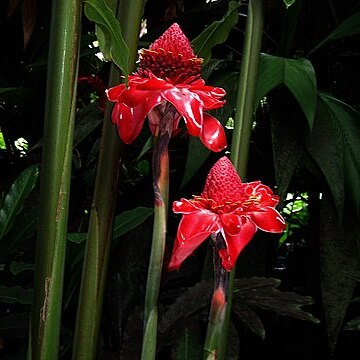Herbs perennial, terrestrial, rarely epiphytic, aromatic, with fleshy, tuberous or non-tuberous rhizomes, often with tuber-bearing roots. Stems usually short, replaced by pseudostems formed by leaf sheaths. Leaves distichous, simple, those toward base of plant usually bladeless and reduced to sheaths; leaf sheath open; ligule usually present; petiole present or not, located between leaf blade and sheath, cushionlike in Zingiber; leaf blade suborbicular or lanceolate to narrowly strap-shaped, rolled longitudinally in bud, glabrous or hairy, midvein prominent, lateral veins usually numerous, pinnate, parallel, margin entire. Inflorescence terminal on pseudostems or on separate, short, sheath-covered shoots arising from rhizomes, cylindric or fusiform, sometimes globose, lax to dense, few to many flowered, sometimes with bracteolate cincinni in bract axils and then a thyrse, sometimes a raceme or spike; bracts and bracteoles present, often conspicuous, colored. Flowers bisexual, epigynous, zygomorphic. Calyx usually tubular, thin, split on 1 side, sometimes spathelike, apex 3-toothed or-lobed. Corolla proximally tubular, distally 3-lobed; lobes varying in size and shape. Stamens or staminodes 6, in 2 whorls. Lateral 2 staminodes of outer whorl petaloid, or forming small teeth at base of labellum, or adnate to labellum, or absent. Median staminode of outer whorl always reduced. Labellum formed from lateral 2 staminodes of inner whorl. Fertile stamen median, of inner whorl; filament long or short; anther locules 2, introrse, dehiscing by slits or occasionally pores; connective often extended basally into spurs and/or apically into a crest. Ovary inferior, 3-loculed initially, 1-or 3-loculed when mature; ovules ± numerous per locule; placentation parietal, basal, or axile. Developed style 1, very thin, placed in a furrow in filament and between anther locules; stigma appearing above anther, funnelform, papillose, ± wet, margin often ciliate. Stylodes 2, reduced to nectaries at apex of ovary. Fruit a capsule, fleshy or dry, dehiscent or indehiscent, sometimes berrylike. Seeds few to many, arillate; aril often lobed or lacerate.
Herbs, perennial [annual], from tuberous rhizome [tuberous roots]. Aerial stems present or absent, unbranched. Leaves basal or basal and cauline, in 2 ranks, differentiated into basal sheath, petiole, and blade, or petiole absent; sheaths often overlapping to form pseudostem, open, ligule present, summit of petiole not differentiated; blade with lateral veins parallel, diverging from prominent midrib. Inflorescences 1 per aerial shoot, terminating short stem without laminate leaves or projecting from tip [side] of pseudostem, pedunculate racemes of flowers or of 2--7-flowered monochasial cymes (cincinni); bracts of main axis enclosing or subtending flowers or cincinni. Flowers bisexual, bilaterally symmetric; sepals and petals differentiated, sepals 3, connate, petals 3, connate, but sepals free from petals; fertile stamens 1, not petal-like; anthers 2-locular; 2 connate staminodes forming petal-like structure (lip) opposite fertile stamen, sometimes also with 2 petal-like or rudimentary distinct staminodes; ovary inferior, 3-carpellate, [1-]3-locular, all locules fertile; placentation axile, parietal, or ± basal; ovules many per locule; style held between pollen-sacs of anther, filiform; stigma funnelform, sometimes slightly 2-lobed; style base free from stamen and staminodes. Fruits capsules or berries; sepals often persistent in fruit. Seeds: aril present; endosperm copious; perisperm copious; embryo straight.
Rhizomatous herbs with aromatic oil cells; rhizome usually fleshy, sympodial, each element terminating in a leafy or flowering shoot. Leaves few to many, entire, distichous; sheaths usually open on side opposite lamina. Inflorescence terminal on leafy shoot or borne directly on rhizome, occasionally surrounded by sterile bracts. Flowers bisexual, solitary in axils of bracts, or in cincinni, with or without bracteoles. Calyx tubular. Corolla tubular at base, the tube often exceeding calyx; petals 3, sub-equal. Labellum (staminodal in origin) adnate at base of corolla tube, usually conspicuous. Lateral staminodes petaloid and conspicuous, or small, subulate teeth, or absent. Fertile stamen 1; anther sessile or with distinct filament; thecae parallel or divergent; connective dorsal, sometimes crested. Style linear, usually held between thecae; stigma usually expanded; ovary inferior, unilocular with parietal placentation or trilocular with axile placentation; ovules several per locule; epigynous glands (stylodes) present as erect outgrowths on top of ovary. Fruit a capsule or fleshy berry. Seeds arillate.
Perianth 6-merous, 2-seriate, the outer calyx-like, the inner corolla-like and often very showy and delicate; outer segments united into a tube, inner more or less united, the posterior segment usually the largest
Leaves in two rows or spirally arranged, with an open or closed sheath, sessile or stalked on the sheath, the blade usually large with numerous closely parallel pinnate nerves diverging obliquely from the midrib
Ovary inferior, (2-)3-celled with axile placentas, or 1-locular with parietal or rarely basal placentas; style sometimes enveloped in a groove of the fertile stamen
Stamen 1, with a 2-locular anther, sometimes accompanied by petaloid staminodes which may form the conspicuous part of the flower (see Fig. 341)
Flowers solitary or in a distinct inflorescence accompanying or separate from the leaves, mostly bisexual, symmetric or asymmetric
Perennial herbs, usually aromatic, with horizontal tuberous rhizomes; stems sometimes very short, leafy or bearing only flowers
Seeds mostly arillate; endosperm abundant, white
Fruit fleshy and indehiscent or a capsule
Ovules mostly numerous

